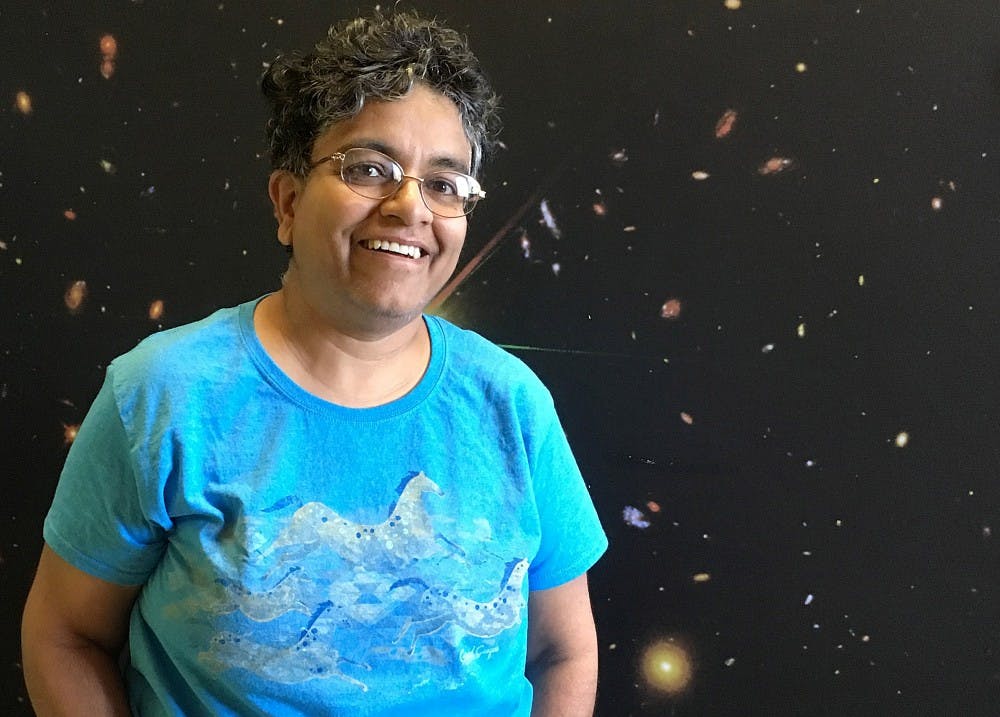Sangeeta Malhotra has wanted to be an astrophysicist since she was 10.
After she took her first physics class while in middle school in India, she said everything in the world made sense. From that point, she devoted her life to science, and after working with NASA to study the depths of the ancient universe, she came to ASU and became a professor teaching astrophysics at the School of Earth and Space Exploration.
Although Malhotra had to sift through complex equations, pass repetitive tests and deal with every other struggle an astrophysicist faces while in the field, she said the biggest difficulty she's dealt with has nothing to do with her research, but rather her gender.
“At every stage in my career, every stage, I've faced that,” Malhotra said. “There has not been a single stage in my life where I haven't been told that I couldn't do this.”
Malhotra’s struggle is one many aspiring female scientists have faced.
Ann Koblitz, a professor who studies women in science at the School of Women and Gender Studies at ASU, said she's met many women who have been discouraged from a science path by their high school guidance counselors.
In many different scientific fields, women are a minority.
According to the National Girls Collaborative Project, women make up about 18 percent of students attempting to earn a degree in computer science and roughly 19 percent in engineering.
On a local level, ASU employs more women in science compared to the national average. Its teaching faculty at SESE is about 22 percent female, according to the staff directory — about 11 percent higher than the national average of employed female physicists.
With 21 women out of their 88 listed faculty members, ASU's school of computing, informatics and decision systems engineering has about 24 percent women, nearly 13 percent higher than the national average of employed female engineers.
Despite ASU's higher-than-average numbers, nearly 75 percent of the faculty in these fields are men.
The low number of women in the field can be traced back to college education. According to the American Physics Society, about 20 percent of all women pursuing a degree in a science-oriented major are studying physics, making the hiring pool of female physicists smaller, while about 17.6 percent of computer science students are women.
Koblitz said that the lack of women represents a larger cultural problem within the community.
“If you look at computer science in the gamer culture for example, there is an incredible amount of sexism that goes on there, just an unbelievably vicious amount of sexist stuff,” Koblitz said. “That seems to have gotten worse lately. In computer science, there were more women in the '80s and '90s then there are now in the U.S. It really seems like that type of sexist culture has taken over the field in a way that wasn’t there in the beginning.”
Malhotra had a similar outlook, saying a sexist culture prevents progress for women in the field.
“It’s going to get worse before it gets better,” Malhotra said. “Issues like sexual harassment show how the culture works. For years, women have been taught to de-escalate problems which makes an issue seem less serious.”
Kimberly Ward-Duong, a Ph.D student studying astrophysics, has a more positive outlook on the field, but acknowledges the possibility of a gender-based disadvantage.
“I haven’t felt disadvantaged, which is probably a sign of the changing times,” Ward-Duong said. “But I have probably been on the receiving end of various biases and have been unconscious of it.”
Ward-Duong said she thinks many of the issues women face are subconscious.
“Despite the fact that the gender ratio in science has improved tremendously, there is still a long way to go,” Ward-Duong said. “A lot of the biases against women and minoritized groups are systemic and unconscious, instead of the overt biases that were expressed in the past.”
Although the stats depict a diversity issue in many science-based careers, there are initiatives seeking to remedy the problem. Organizations like Compugirls, an ASU-based initiative with the goal of encouraging girls to pursue careers in computer science, are promising ventures to make change.
With a daughter entering college with an intent to major in biology, Malhotra said improvement is a personal issue not just for her, but to ensure her daughter will have a better experience as she enters the field.
“It’s a very complicated problem; cultural change isn’t easy at all," she said. "You can say what you want, but the question is: Are you doing anything about it?”
Reach the reporter at Emmillma@asu.edu or follow @Millmania1 on Twitter.
Like The State Press on Facebook and follow @statepress on Twitter.





